Acco or Acre is a historic walled port-city with evidence of continuous settlement since the Phoenician times. It lies to the north or Caesarea. The present city is characteristic of the Ottoman times and dates from the 18th and 19th centuries. The remains of the crusader citadel lies under the city and dates from 1104-1291. It was regarded as the capital of the crusader kingdom of Jerusalem.
 |
| View from Ottoman fortifications of Acre |
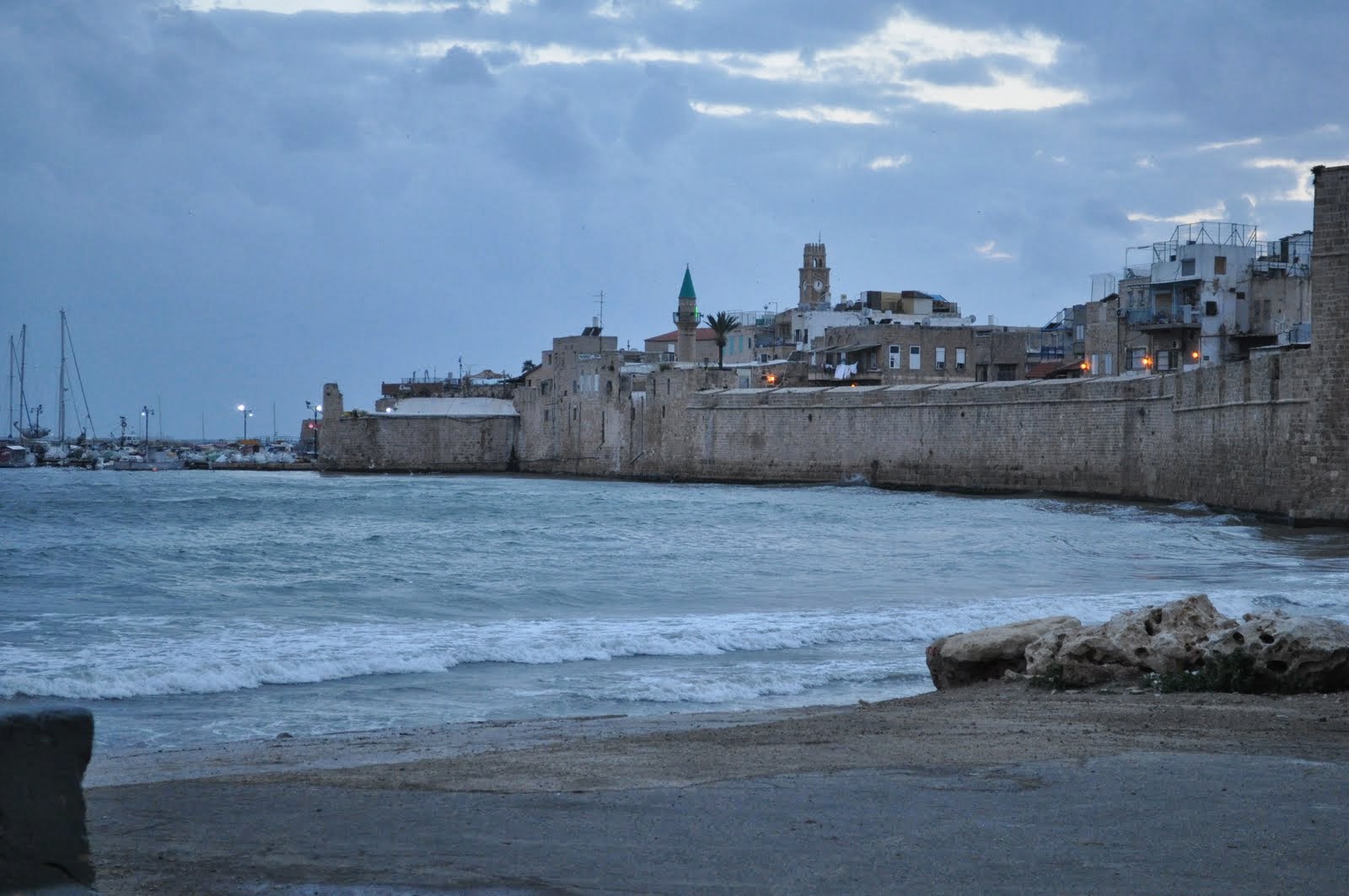 |
| Acre Port |
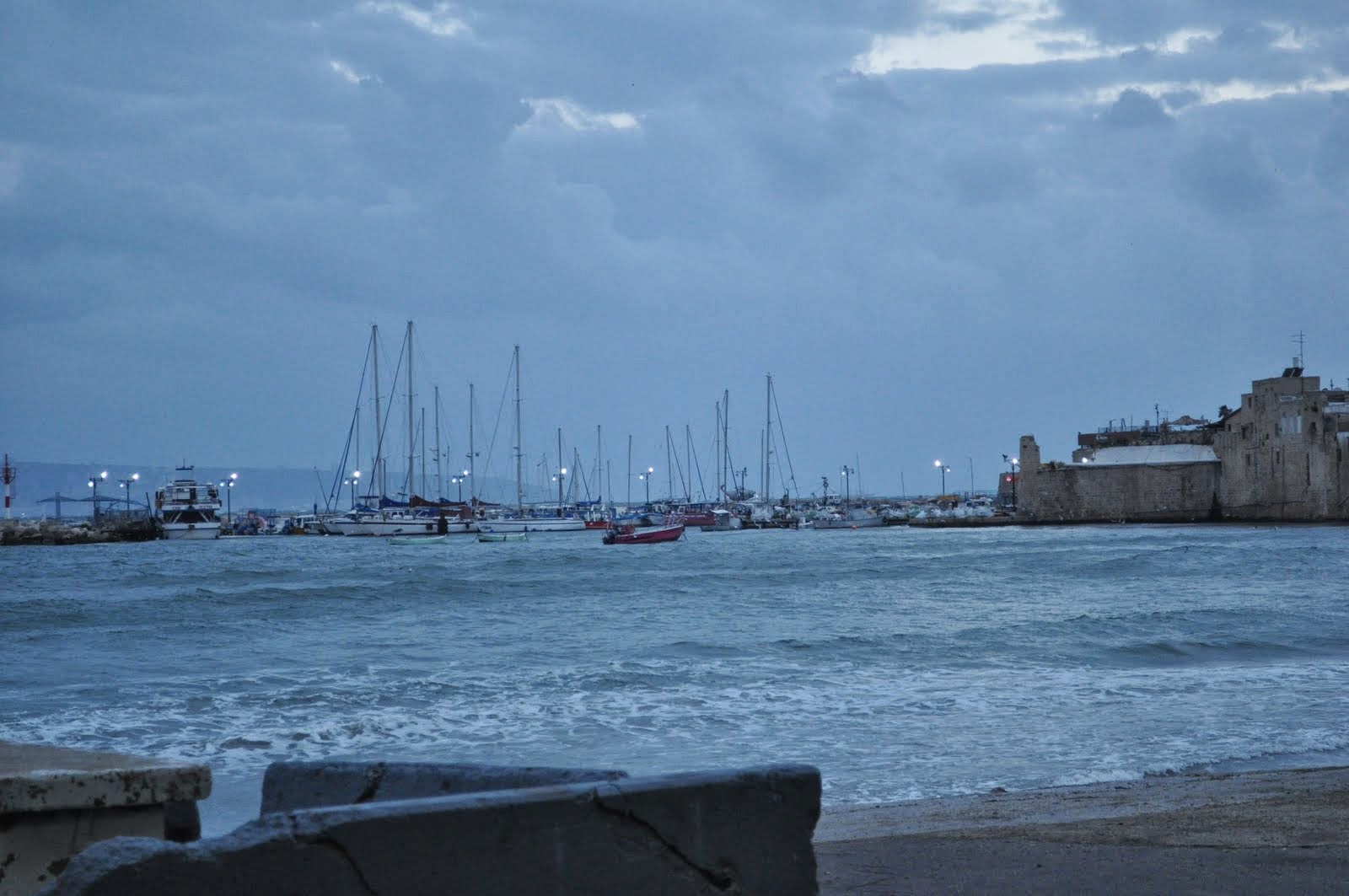 |
| Boats in Acre port |
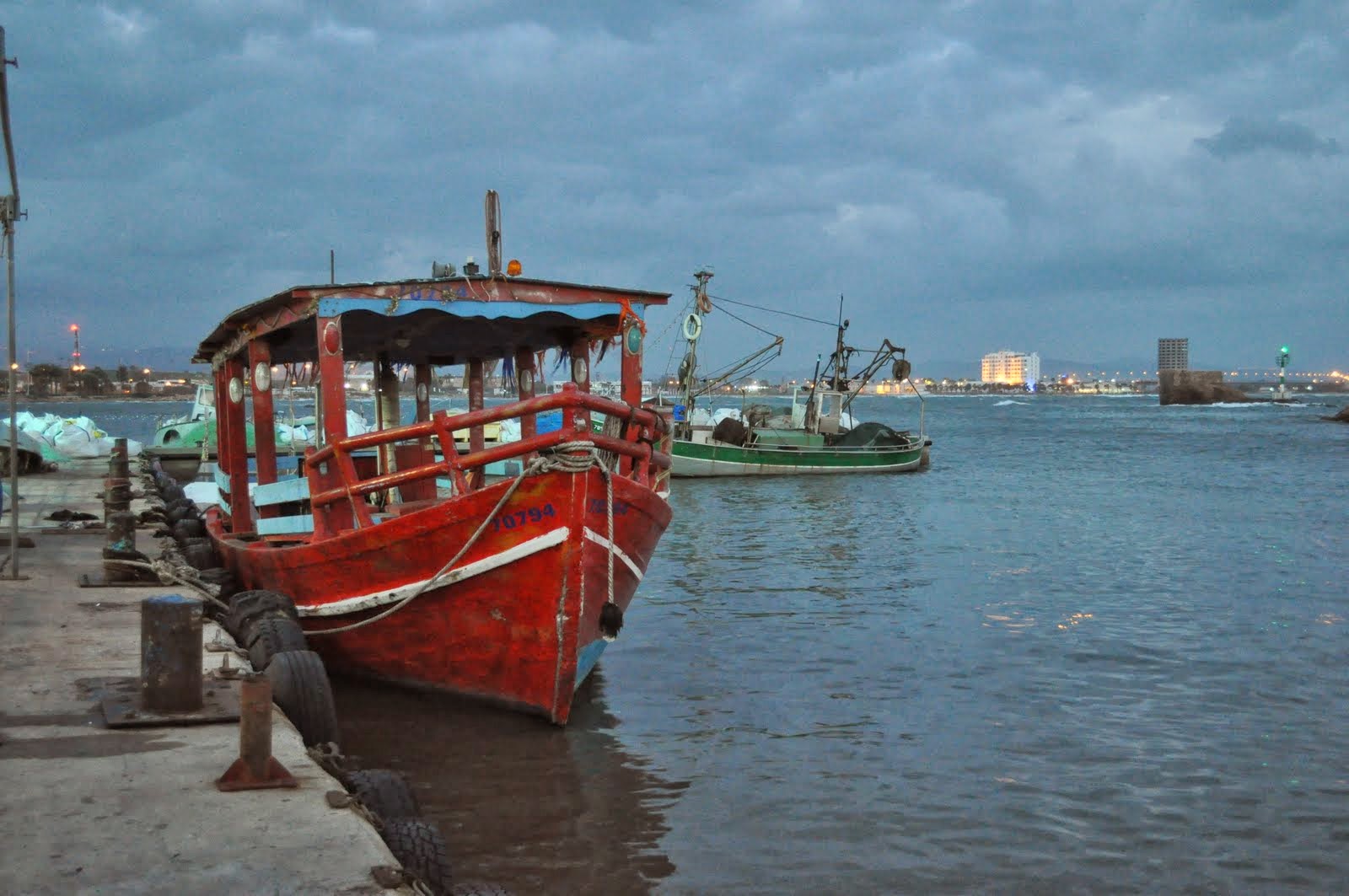 |
Rocking boat ( hard to see here) Acre Port
|
The Crusader citadel was underground. The Museum was in the process of modernisation. There appeared to be preparations for projections, re-enactments and static displays like models of rooms of the time. It was freezing underground so heating might also be needed. We bought a ticket for 3 displays but one was the tunnel which both Steve and I would have to have bent double to see so we avoided that one.
 |
| Part of old town now restaurants |
 |
| Knights Citadel, amazing figs made an oasis in a land with few trees |
 |
| Beginning of modernisation of museum- Knights' banners |
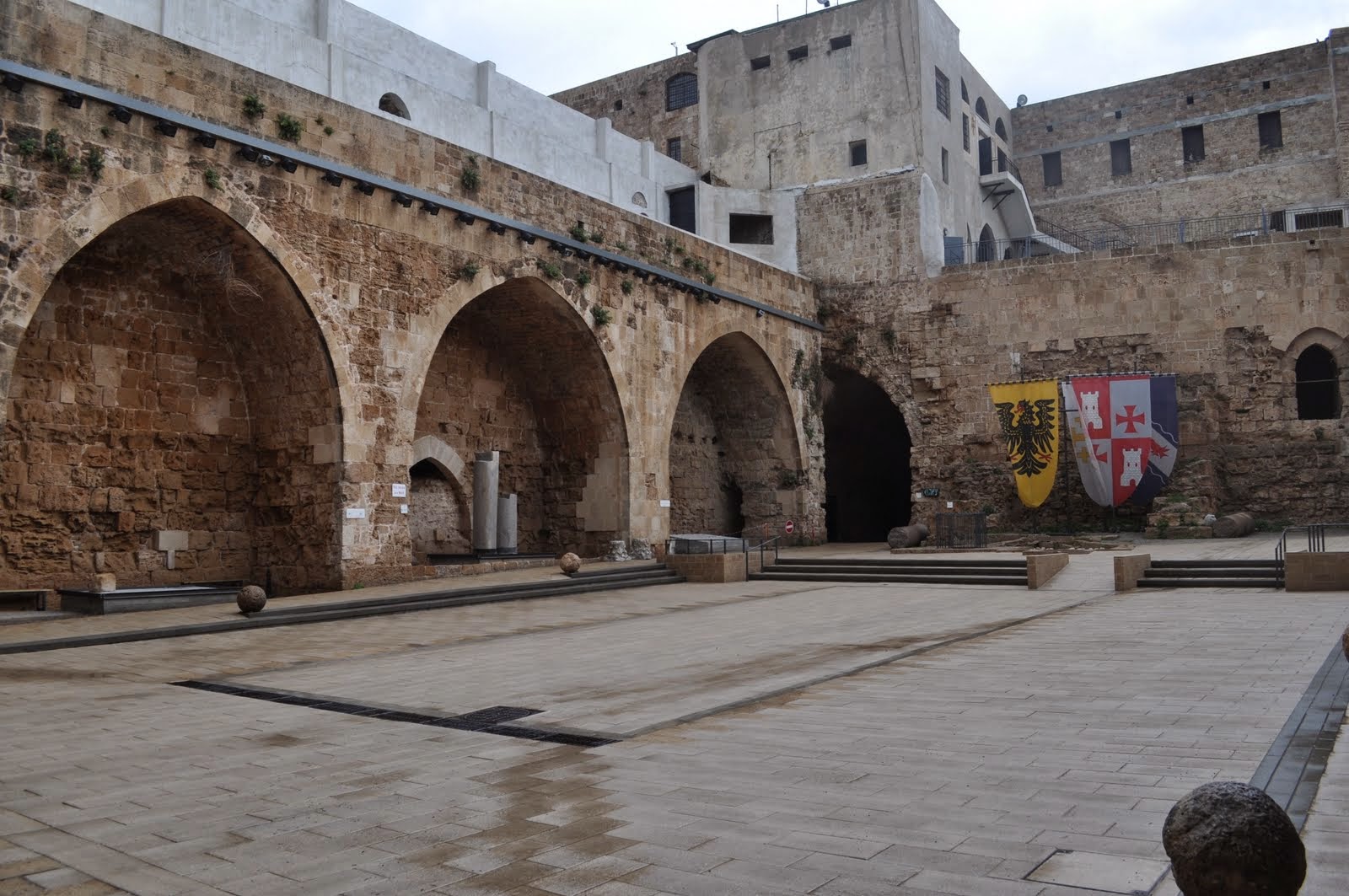 |
| Knights Citadel- see cannon balls |
 |
| Citadel |
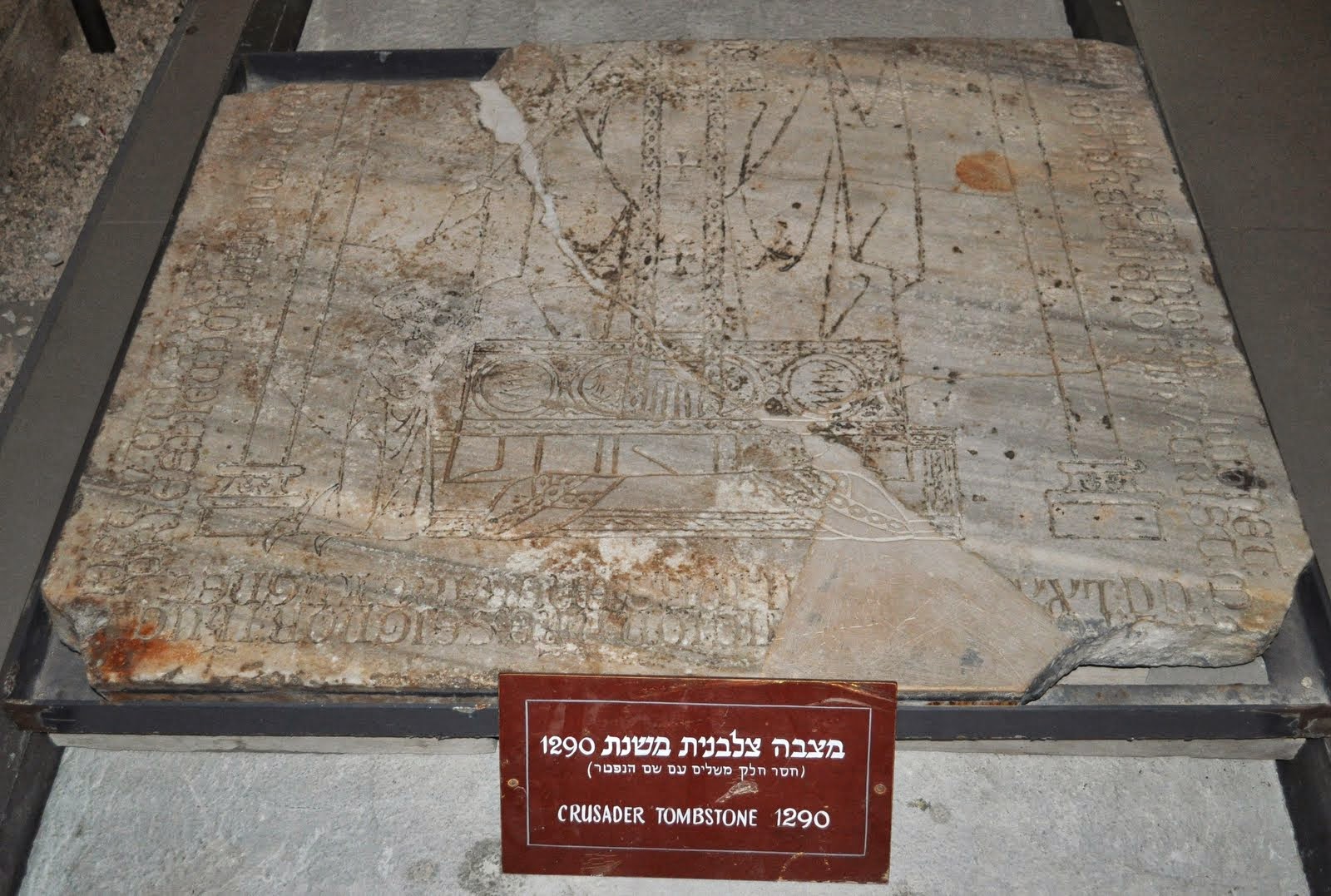 |
| Crusader Tombstone 1290 |
 |
Note the fleur -de -lis- traditionally used for French Royalty. Reported to have been adopted in 12th century by them on
their shield.
 |
| Hummus in the making |
|
Acre was another place for us to try hummus. This time we joined lots of locals and school kids for lunch. See the cook above.
We then drove inland. In a country which is only 424 km from north to south and it's width ranges from 114km to its narrowest point 15 km, it wasn't that far. However as we found in Britain, lots of winding ways make for a long journey at times.
The next region was the Galilee. We had been told there had been rain so the area would be green. This was certainly the case. We were to also drive in the south through desert, providing evidence that for a small nation Israel is geographically diverse.
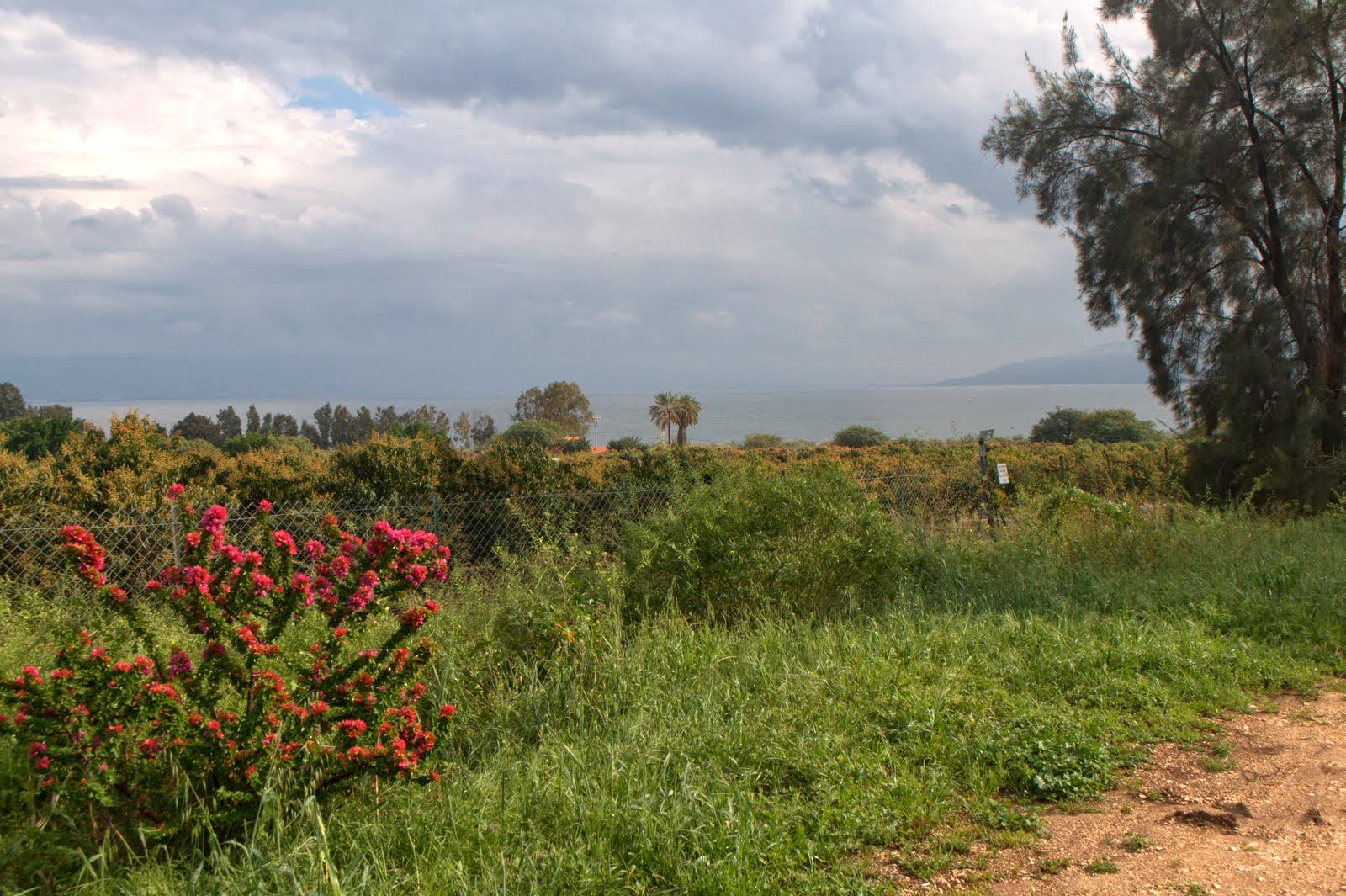 |
| Our first hazy afternoon view of the Sea of Galilee |
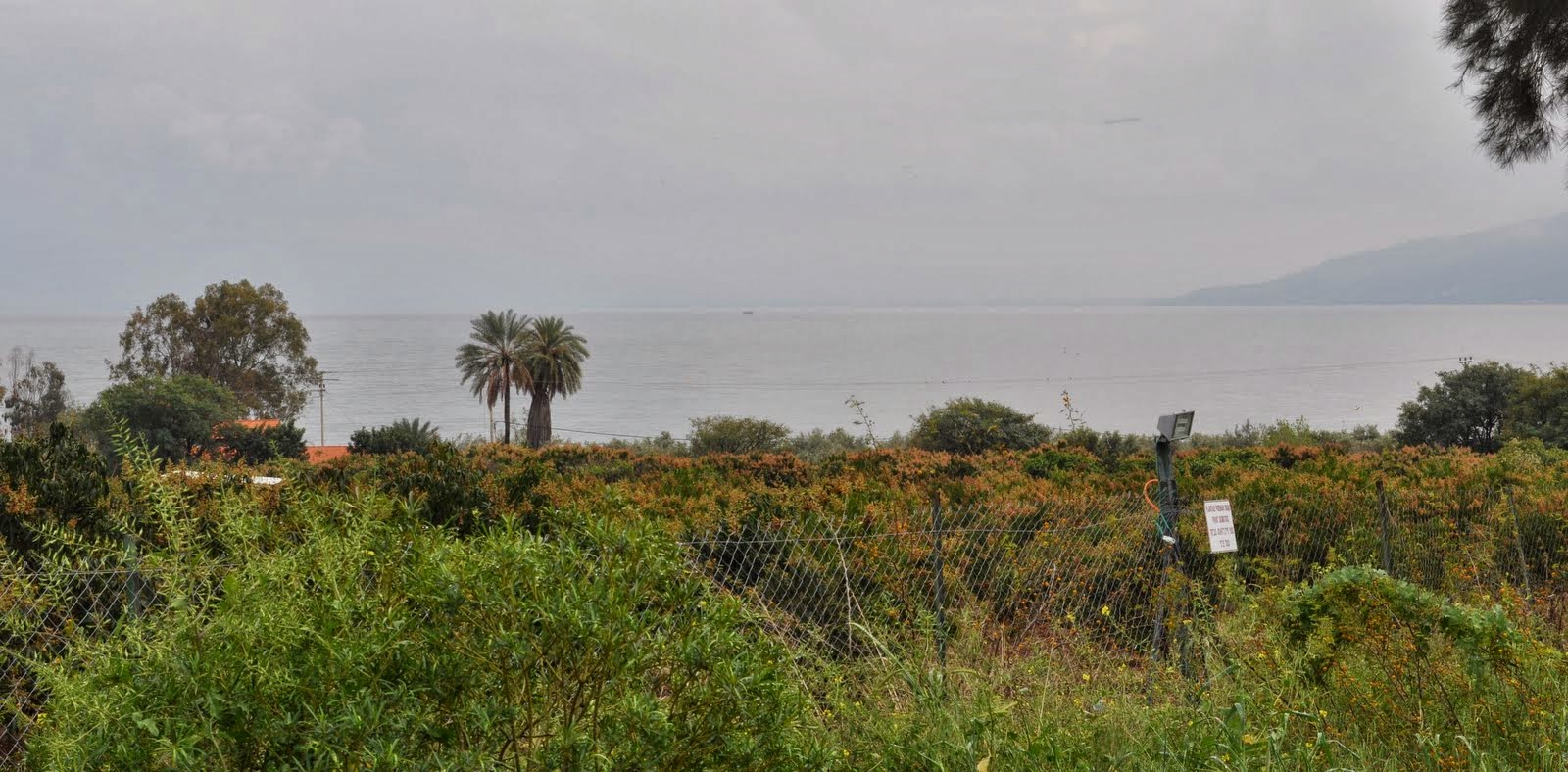 |
Sea of Galilee( north)
|
My only experience of Christianity is as follows. I went to Sunday school at All Saints Parramatta because our neighbour taught there; I borrowed the Bible in Year 2 because I liked the pictures and at Parramatta High and Parramatta West Primary I engaged with the scripture teachers for debating practise, or really target practise I am clearly not religious. Friends thought we went to Israel as part of a pilgrimage. For Steve and I this is far from the truth. However one can't help being affected by visiting the sites here, in relation to their religious history and the geography.
Galilee was significant because it is here that Jesus spent most of his time. He gathered his followers and a series of "miracles" is said to have occurred in the vicinity. As a student of history I am always in a state of awe when visiting places of historical interest: the Great Wall, the battle of Culloden, Stone Henge, Bath, the Western Front are just some we've visited. I try to imagine myself in the time. Just because I am not a Christian doesn't mean I treat sites like Galilee or Nazareth with any less fascination. That would be ignorant.
Steve has referred in his blog to the importance of this area in relation to the events which took place here and their impact on contemporary events: the crisis in the Middle East, the impact of colonialism, the spread of Christianity and Islam, and the treatment of the Jews through out time. So yes, fascinating and significant sites are to be engaged with in Israel for "believers"and non- believers". I was quite astounded by the impact this 10 day period had on me. It certainly didn't make me take up the Bible, Torah or Koran. But I was taken by the enormity of the belief that is the story of Palestine, Israel, the Promised Land or whatever you may call it.
The zeal with which people express their "faith" always amazes me. I suppose it shouldn't since I too have heart felt political beliefs that I have "always" been keen to share. A few come to mind. I was walking in Caperneum, on the northern shore of the Sea of Galilee. This site is significant since it is where Jesus is said to have healed people and was the home of a number of his apostles. Jesus set up his ministry here after leaving Nazareth. Buses carrying pilgrims alighted here as at the other sites of biblical note. As we were walking towards the gate of the ancient site, two people walked passed, having just been into the site. The man said, " You know sometimes I think that there is just as much truth in what is not said in the Bible as is said.." I winced at this statement and really stereotyped him instantly, however what this demonstrated was the power of faith or belief. Incredible. The statement made perfect sense to both he and his friend. This was just the beginning of what I witnessed as evidence of religious belief in Israel.
Tsfat sounded an interesting place to visit. It is described as a mystical place. It was freezing and raining. We arrived to see many orthodox jews, recognised by their hairstyle and clothing.
There was also an artists colony.
We stayed the night in Tiberius on the southern shore of Nazareth. It is a bit of a party town and is a bit down at the heel. After walking into town looking for dinner we finally settled again for a falafel wrap. Hummus and wraps became a bit of a staple in this expensive country.
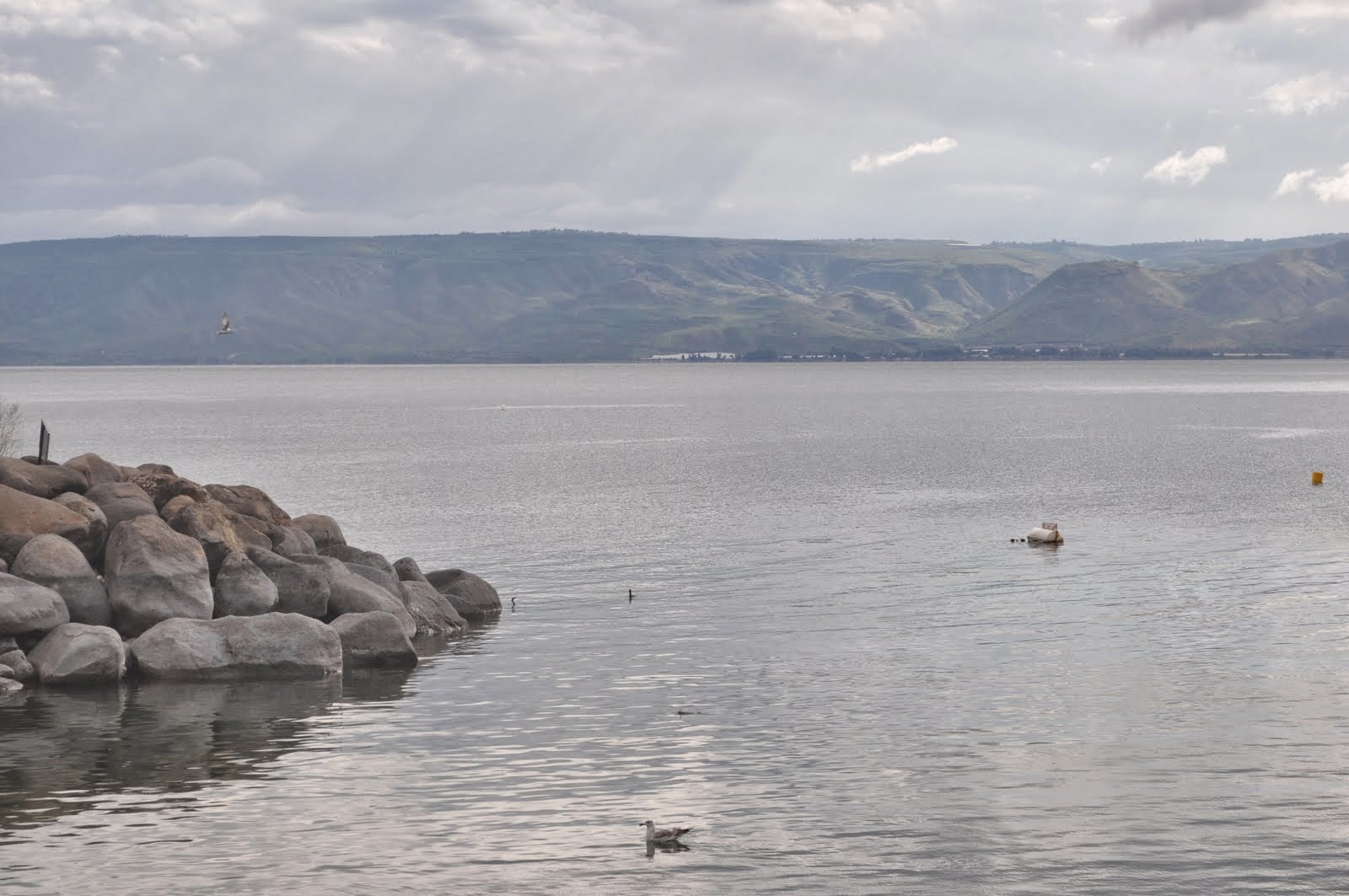 |
| Tiberius on the Sea of Galilee and view of Jordan |
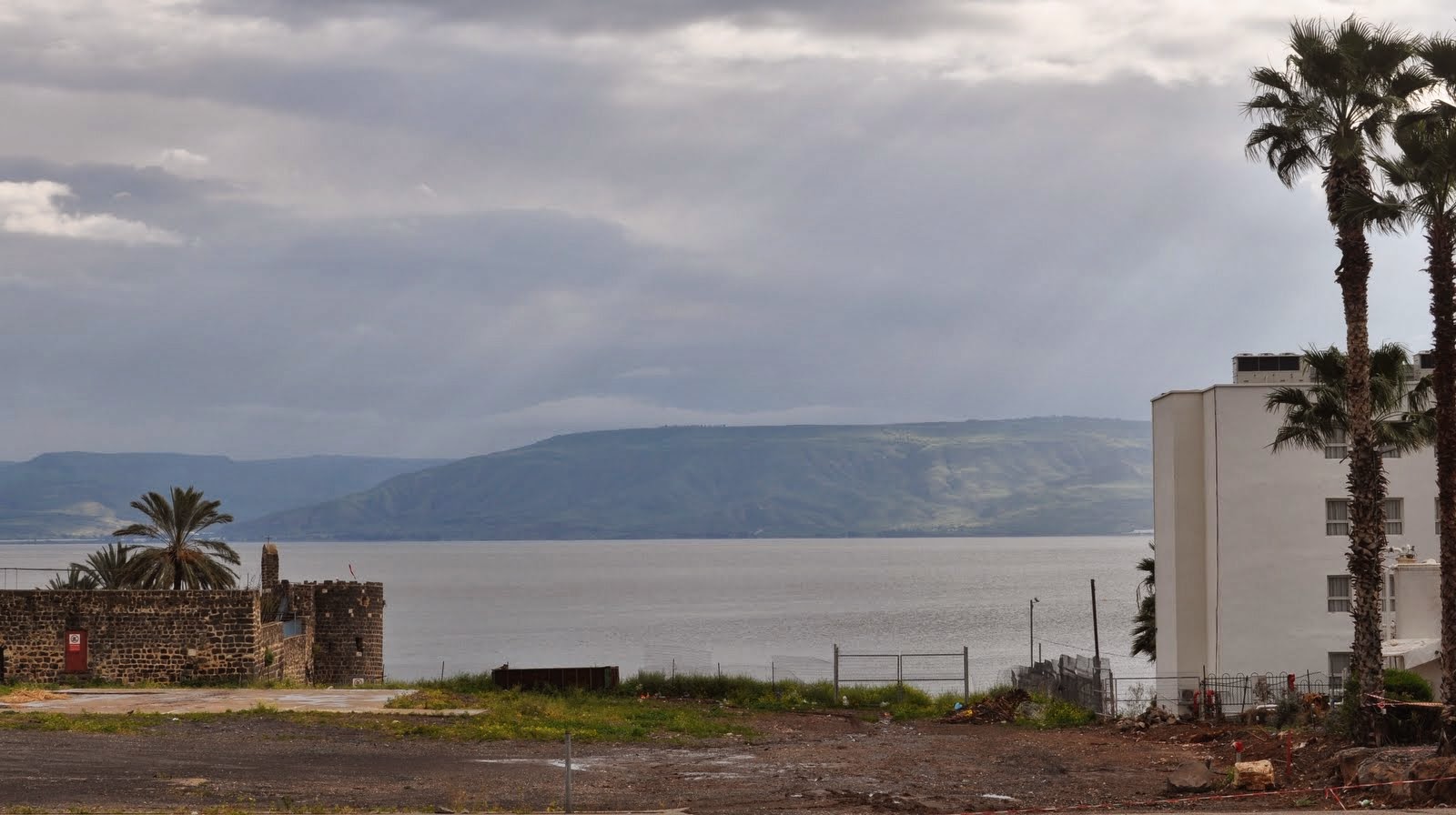 |
| Sea of Galilee |
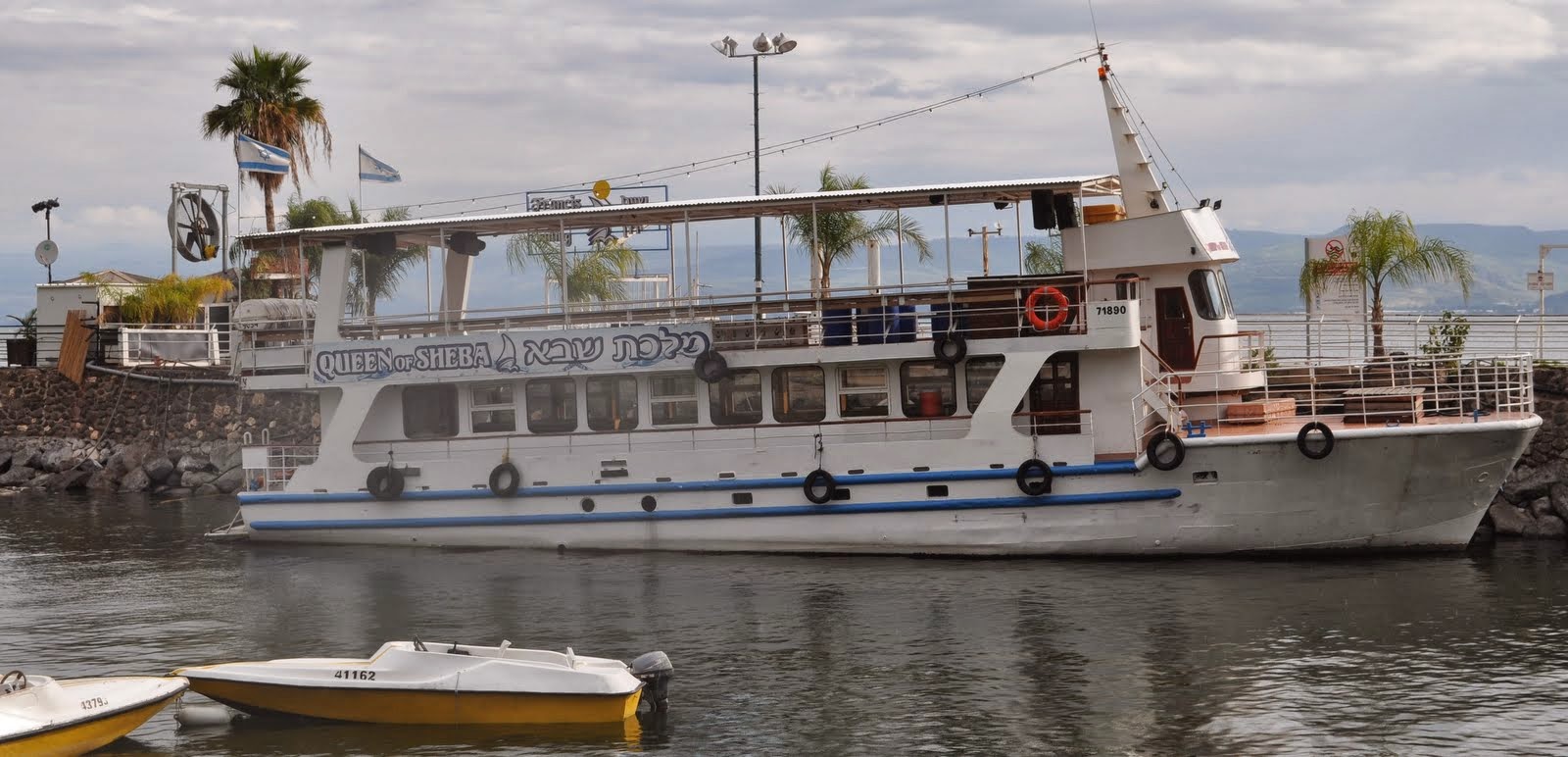 |
Party boat in better times, it is winter after all
"The Queen of Sheba" |
 |
Israeli tourism is my guess
Grockle would be our term for this. |
Heading south we decided to stay in Nazareth. It was only a short drive from Tiberius. Fortunately we had booked accommodation ahead. There certainly aren't as many places to stay. The internet had proven invaluable for booking ahead and getting directions. Following the blue dot on the iPad is always interesting. This time we believed it was wrong. We wound our way up hill right into narrow lane land, Steve's favourite. He managed to get us out of there and we continued up the hill following what we believed was the route to our hostel. Again I got out to ask directions, a common event. A very helpful young man in the fruit shop in told us excellent English to go back the way we came and yes, it was where we had been. We parked the car in a car park and followed the signs to Abu Saeed Hostel. It was Shabbat so some shops were shut but as we were to learn it was a predominately Moslem town so not all were closed. It is known as the Arab capital with 69% Moslem and 30.5% Christian. In fact as we drove around we came to believe that most Jewish Israelis seem to live in Tel Aviv and Jerusalem.
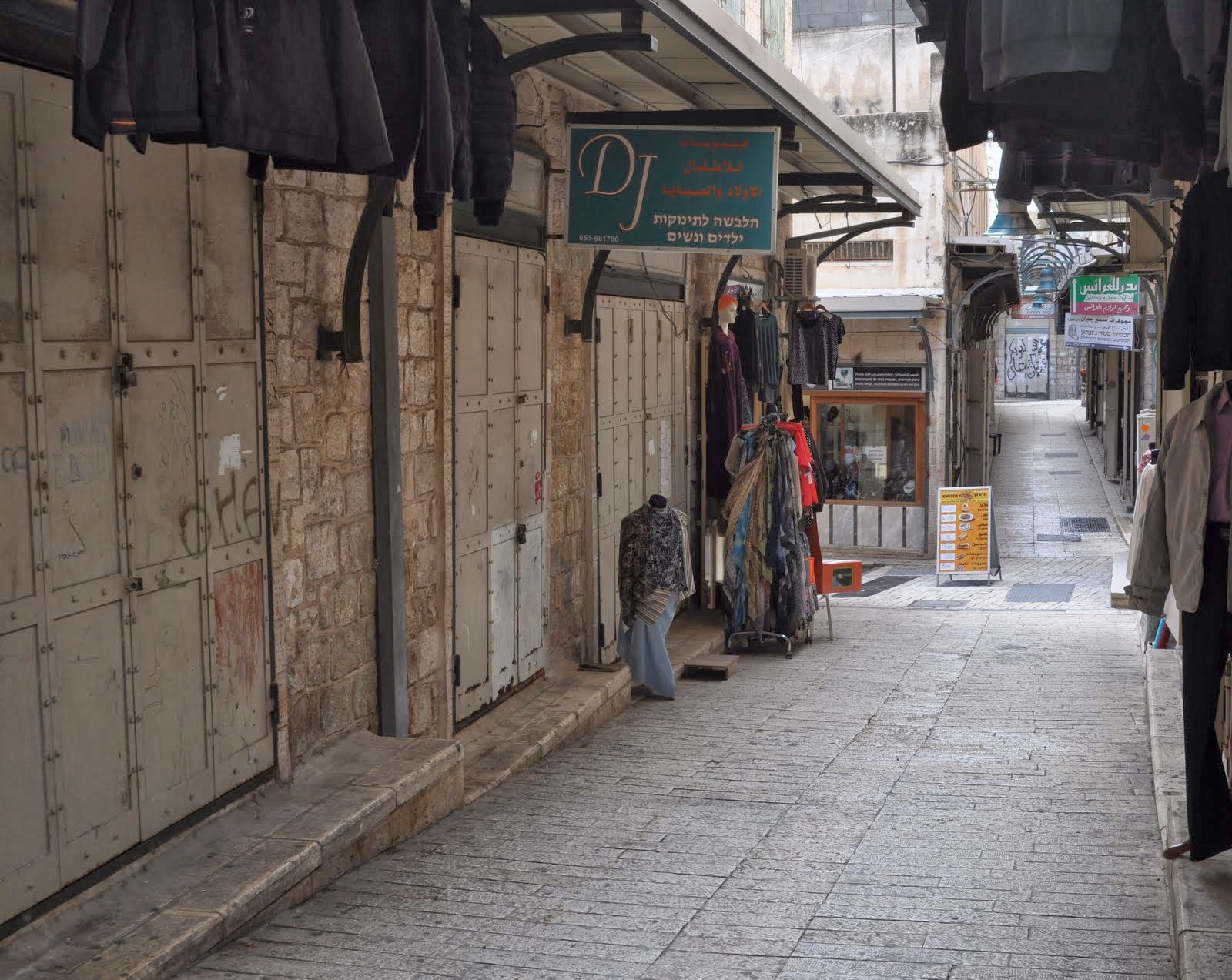 |
| Amazingly heavy doors closed shops from view |
 |
| Narrow pathways wound up the hill |
 |
| Churches abound in the land of the Nazarene. |
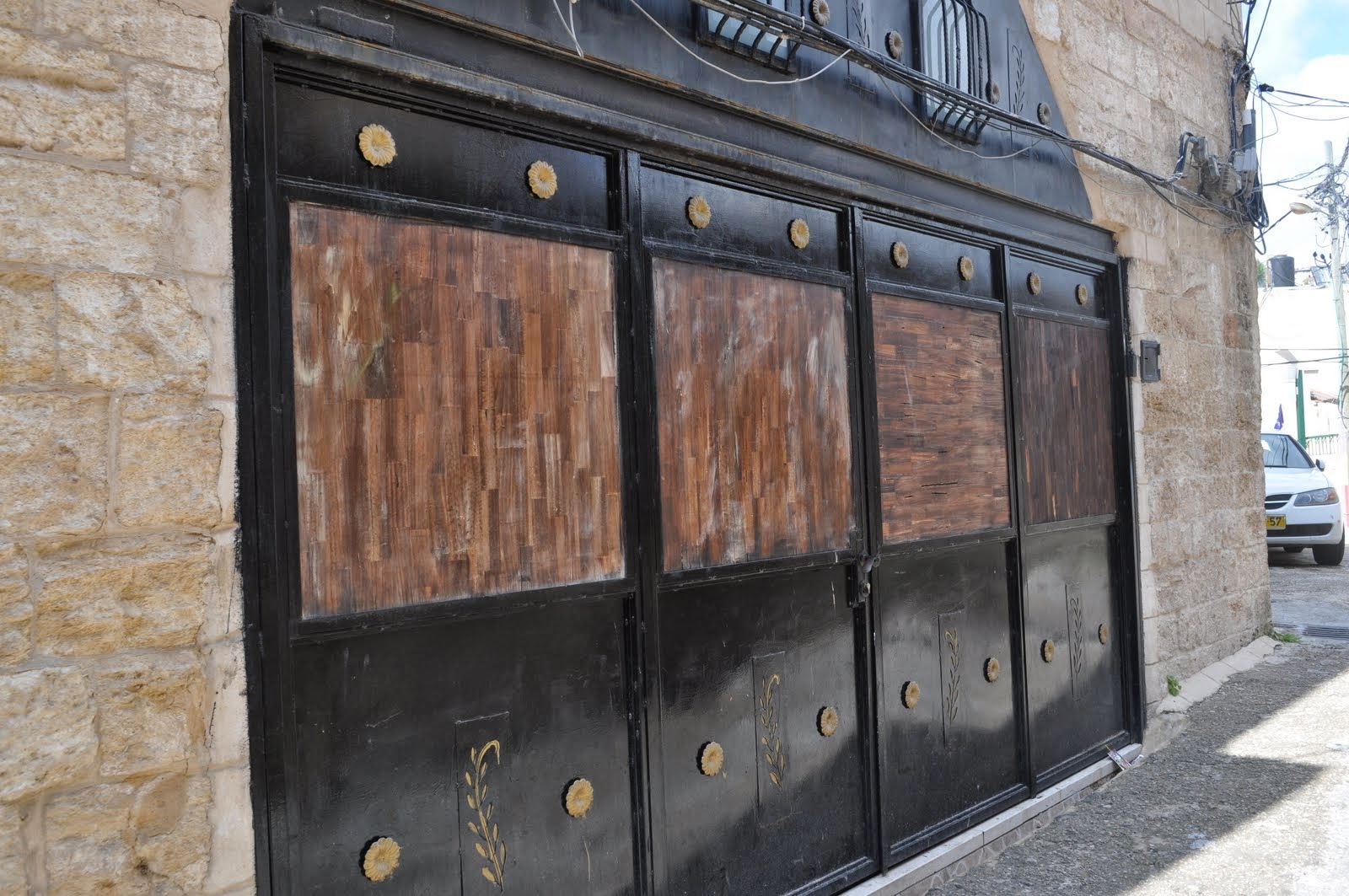 |
| Security is clearly an issue |
 |
| Church of the Annunciation Nazareth |
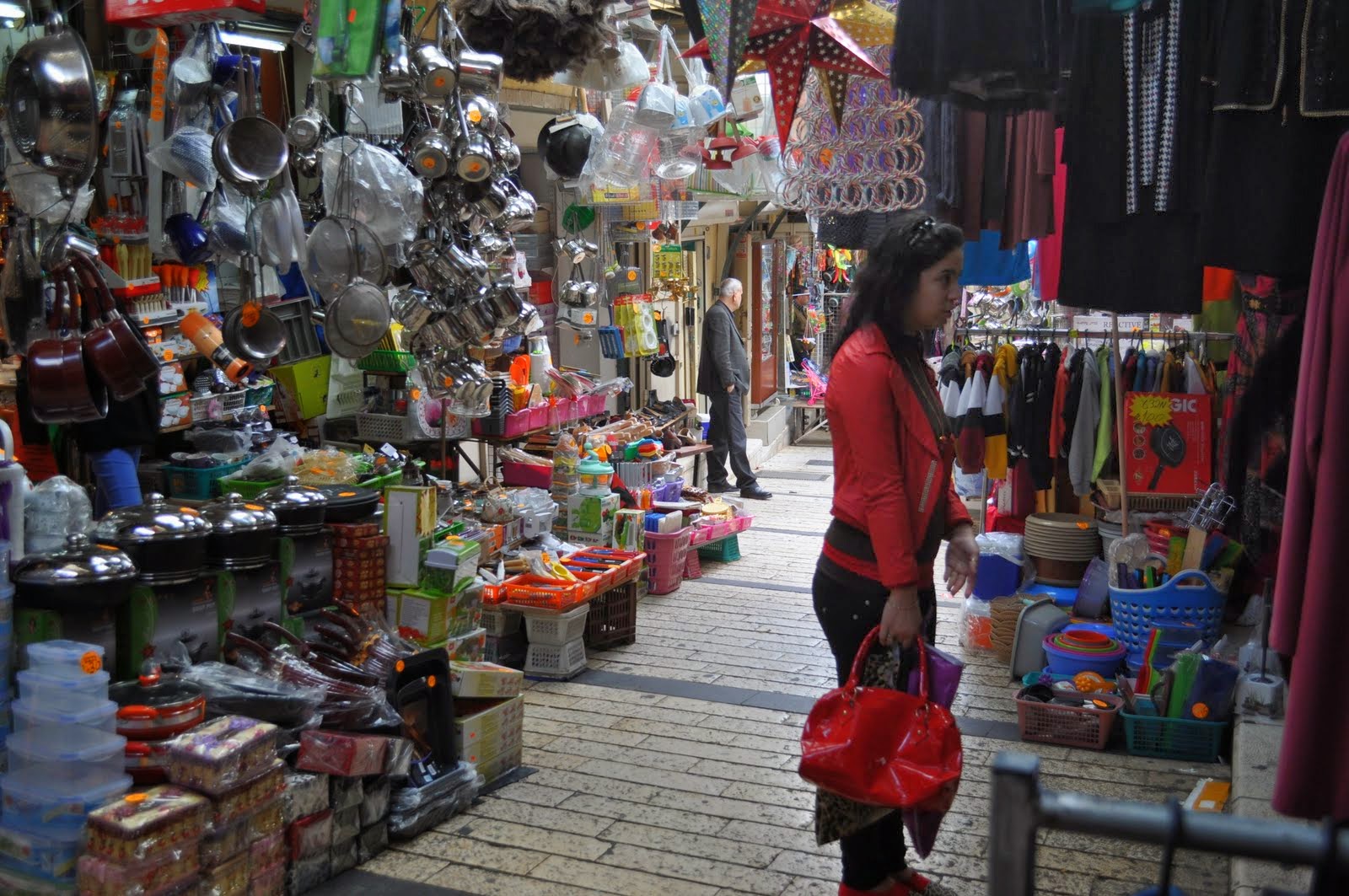 |
| Markets not unlike Turkey |
 |
| Lots of drums |
We needed to get out to see as much as we could. Nazareth would have been a place we could spend more time. We visited the Church of the Annunciation. It is a modern church built on the site of earlier churches and said to be the site where Mary was told by the angel Gabriel that she would give birth to Jesus. Again many tour groups were there: English, American, French. The modern building is like a fortress. The inside is concrete and rather bunkerish. One imagines the Christians hiding in here if under threat.
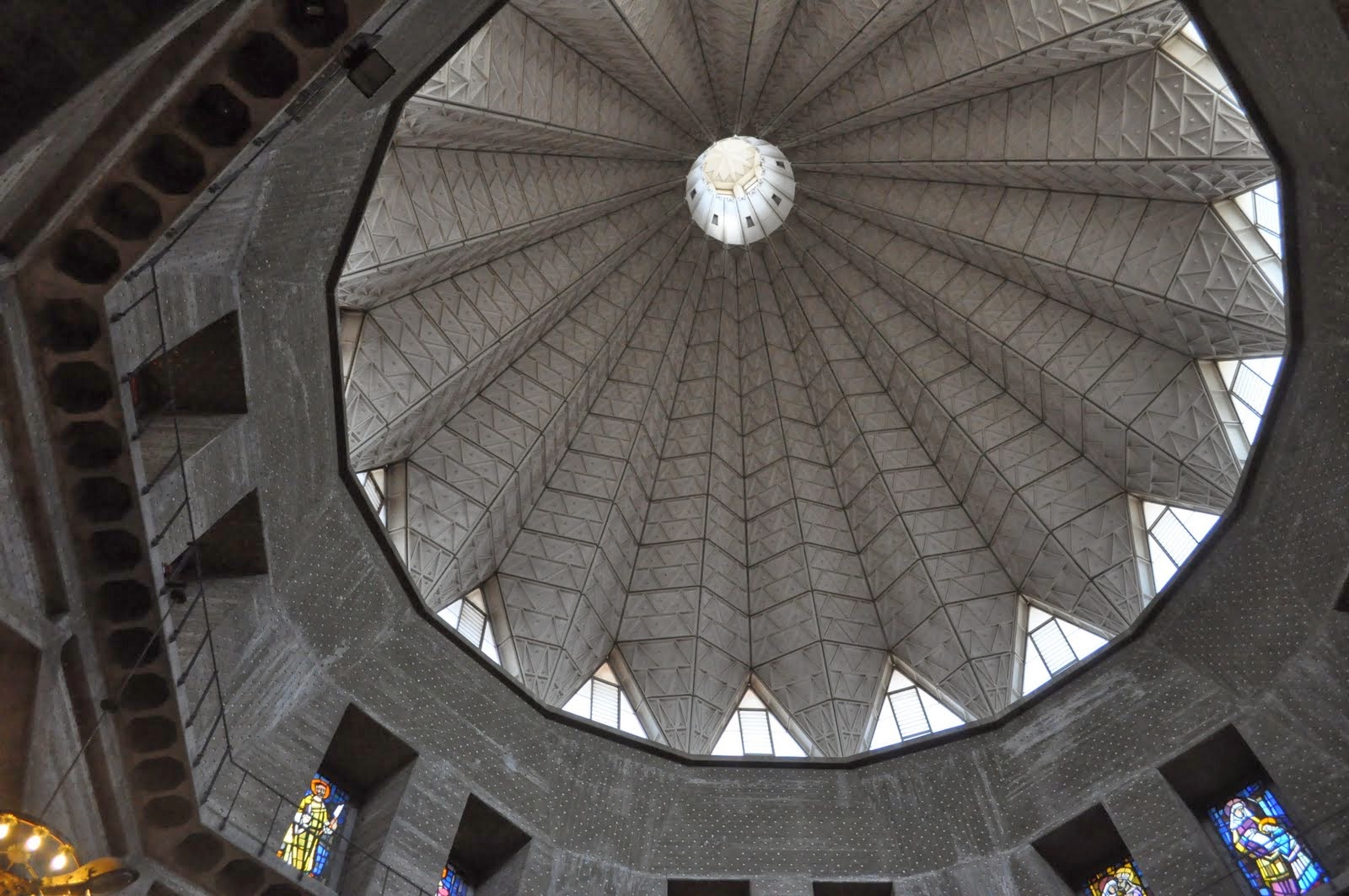 |
| Views of the Church of the Annunciation |
While we were in Nazareth, rockets were being fired between Gaza and Israel. To protest the Israeli response a protest was held in Nazareth. Clearly this was a town sympathetic to the cause of the Palestinians, being predominantly Moslem. I have always been interested in protests and demonstrations in other countries, however I kept remembering the smart traveller advice about staying away from such actions, so I felt rather anxious while nearby. We had seen water cannon accompany riot police in Mugla.
 |
| Quite an orderly protest |
Early next morning we took off for the Dead Sea. We had booked accommodation here on the southern end of the Dead Sea at Neve Zohar. The drive here was fascinating. We entered the
region called the Negev. This was desert. I have seen photos of desert and expected sand. It was a lunar landscape. From a distance it looked like sand or smooth, but on closer inspection the land was covered in small rocks. I couldn't imagine what it must be like to walk over it as the Bedouin people. Here you see true oasis, camels, and corrugated-sheet homes of the Bedouin. Once they used tents. The area looked poor and inhospitable. What a contrast to Tel Aviv or any of the towns we had seen so far.
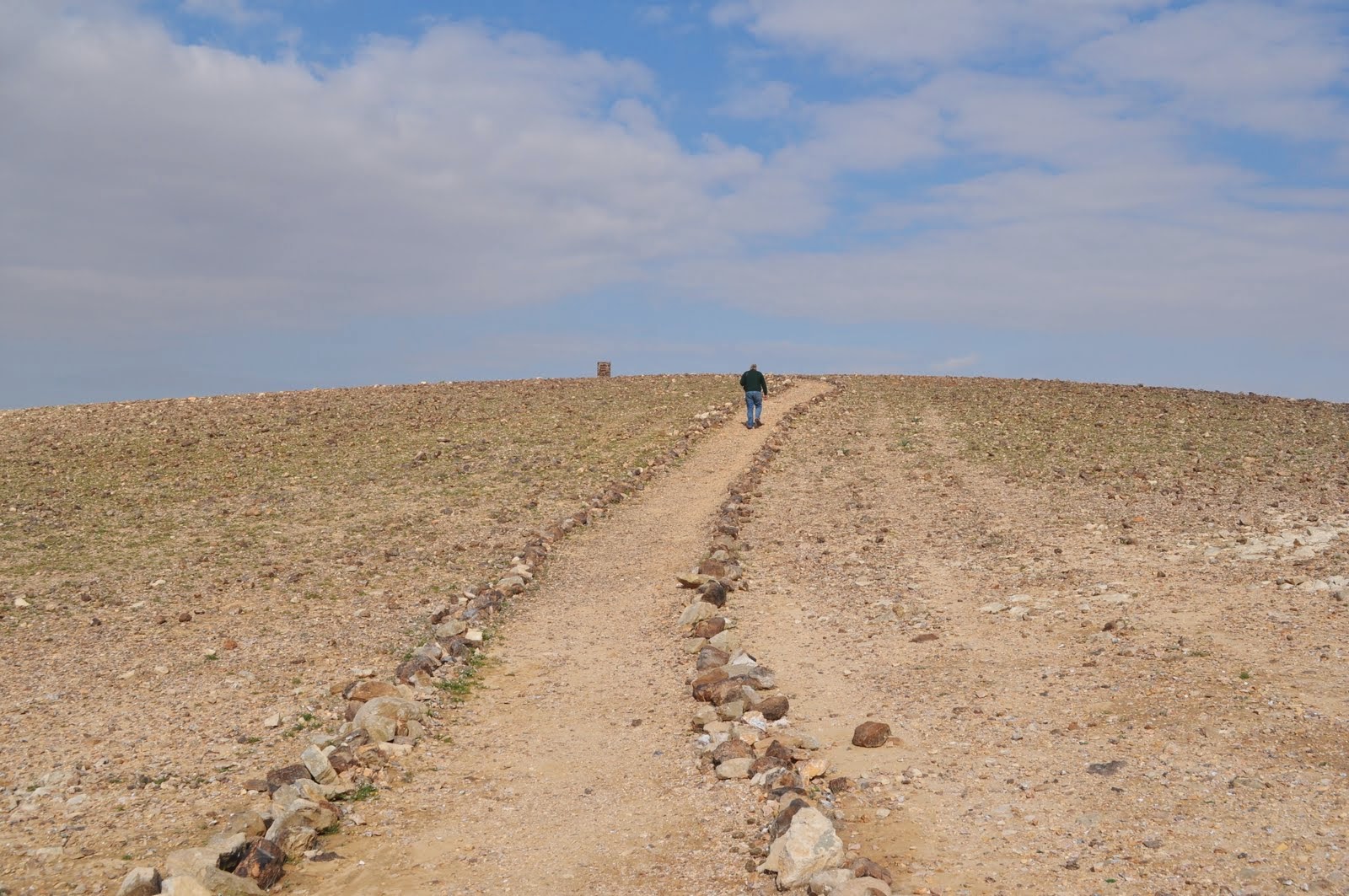 |
| Steve climbing to gain some perspective on the area |
 |
| Negev |
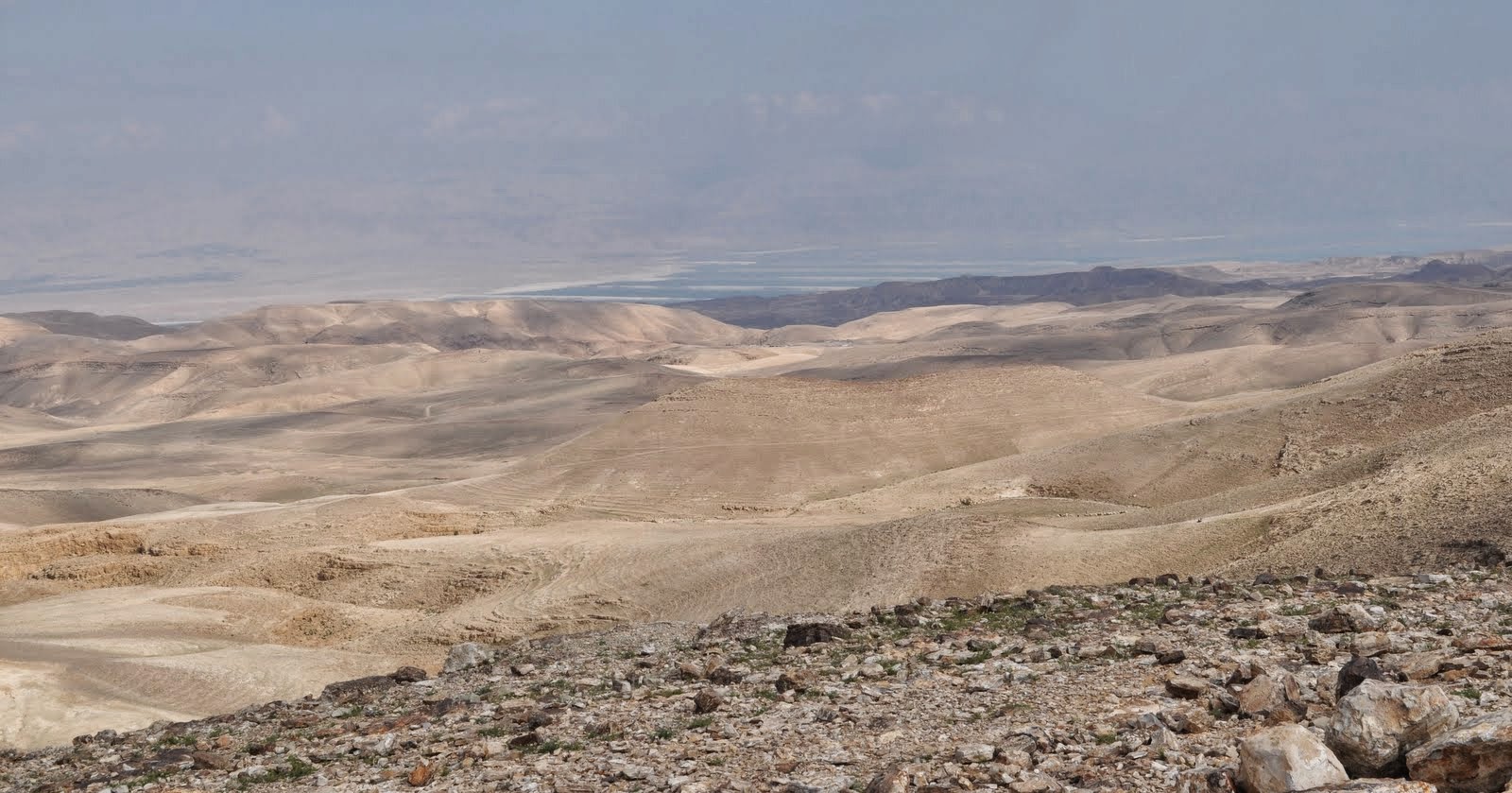 |
| Notice the rocks in the foreground. |
While researching Israel I had read about having a "Bedouin" experience: tents, eating under the stars, riding camels. On the way to the Dead Sea we came upon such a "hotel". What a stark contrast to the way the Bedouin live now. It was a bit like a "then and now" experience as we drove past and found Bedouin herders, their flock and their homes. It was Bedouin who discovered the Dead Sea scrolls in Qumran in 1946. Bedouin live also in Saudi Arabia, Egypt, Syria and Jordan. Many of their settlements are not recognised by Israeli planning laws.
 |
| Bedouin Experience |
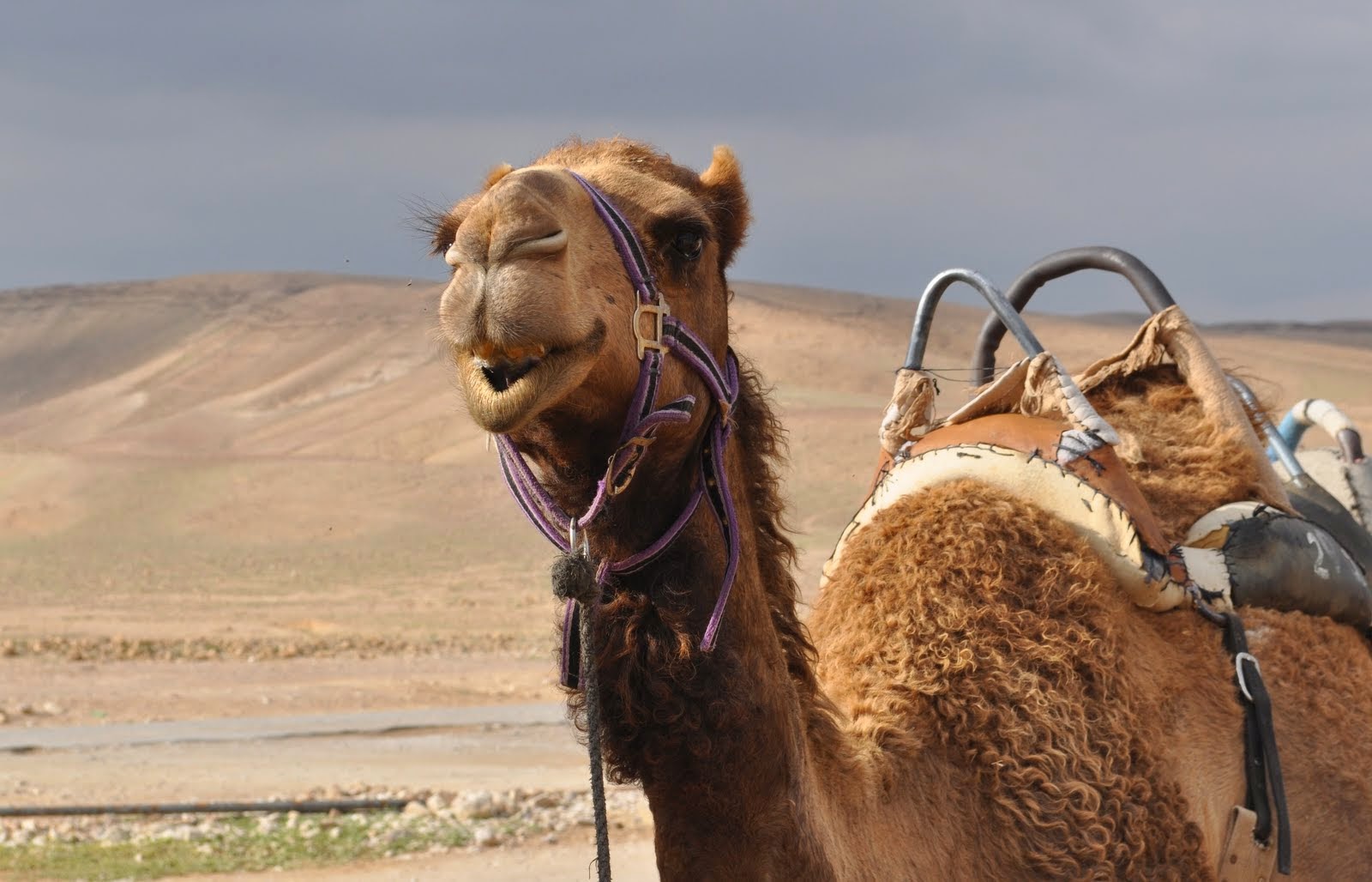 |
| " I dare you to come for a ride!" |
 |
| Communal eating area |
 |
| Sleeping huts |
Stopping for a snack at Adad we discovered a Russian community shop. Vodka, pickles, all sorts of russian products. Adad is modern day Caanan. The sign said Masada and the ipad seemed to show a road linking this archaeological site and National Park to the Dead Sea. So we set off. We finally reached Masada after driving down a long winding road. Masada was the site of a mass suicide of the people living there when the Romans besieged the city in 73AD. The settlement is on top of a large stoney plateau. We probably should have gone in but it was getting late and after a discussion with the staff at the gate realised that we had to drive all the way back to Adad and go further south to Neve Zohar.
 |
| Masada |
 |
| Dead Sea, see the salt on edges |
Approaching Neve Zohar the road winds down to 500 m below sea level. The local authority have placed large signs indicating how far you are going: 100m, 200m, 500m. Neve Zohar is the poor end of the Dead Sea in relation to accommodation and swimming. Signs indicate that you are not allowed to swim here. Further along the shore line as you travel north, swimming is allowed in small areas. Normally these are associated with a hotel or park.
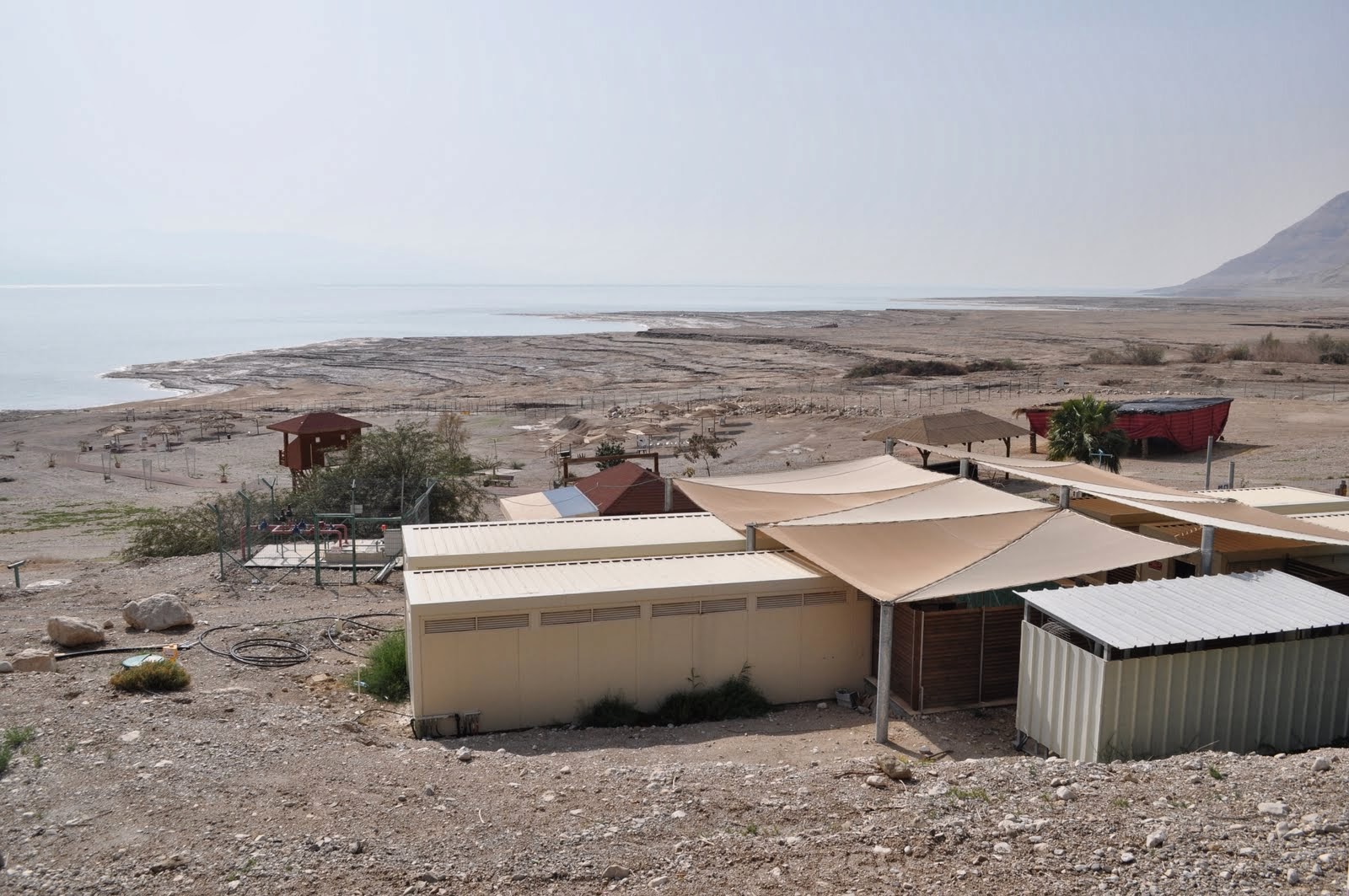 |
| Swimming spot- not that appealing really |
The water was oily, thick and don't taste it! Salty!!!!! Signs also indicate not to wear gold in the water, don't put your head under,.....lots of don'ts. It didn't really appeal to me.
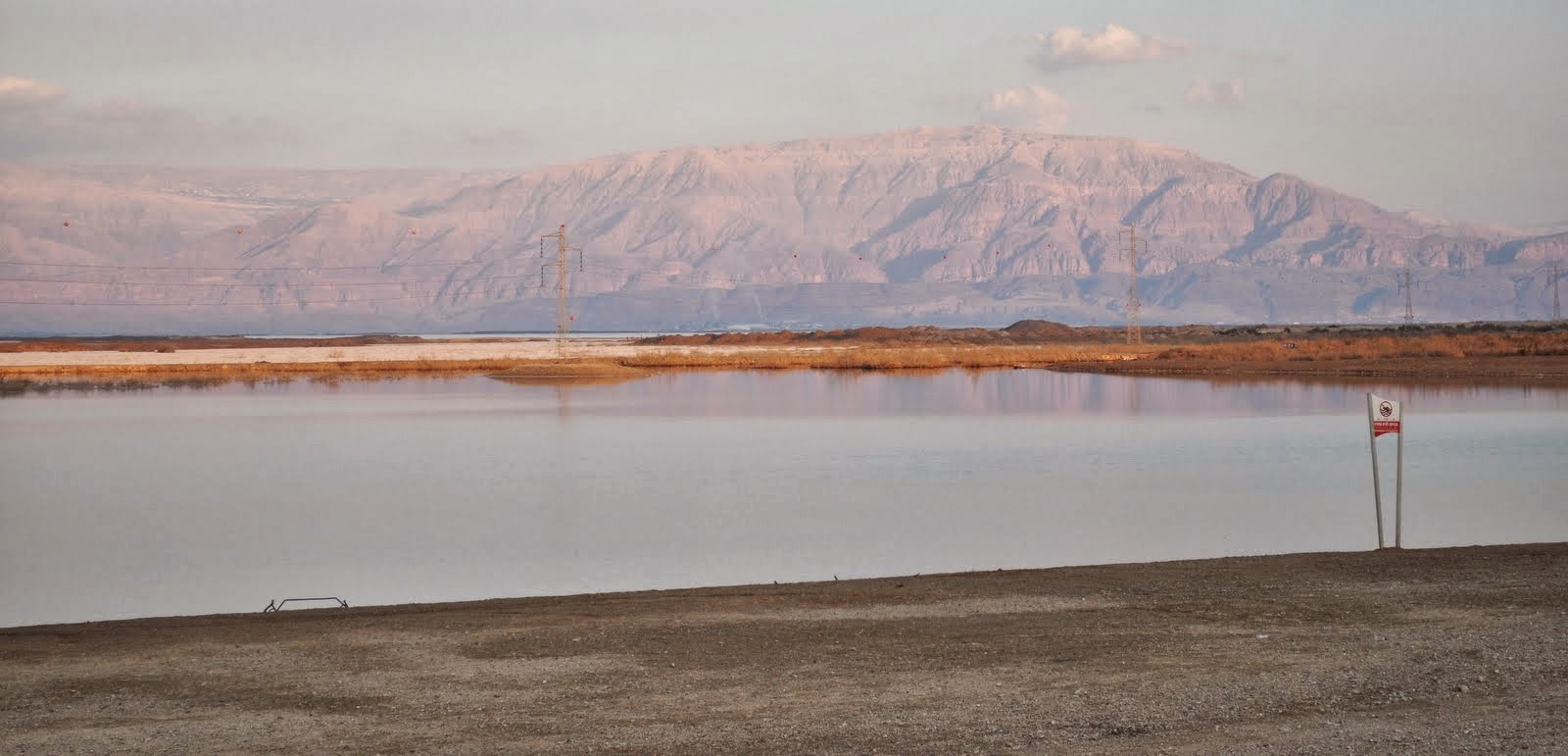 |
| Signs appeared everywhere saying " no swimming" |
We drove north to Ein Gedi. Here there is a kibbutz and a nature reserve. Lush growth stands in stark contrast to the rocky cliffs behind.
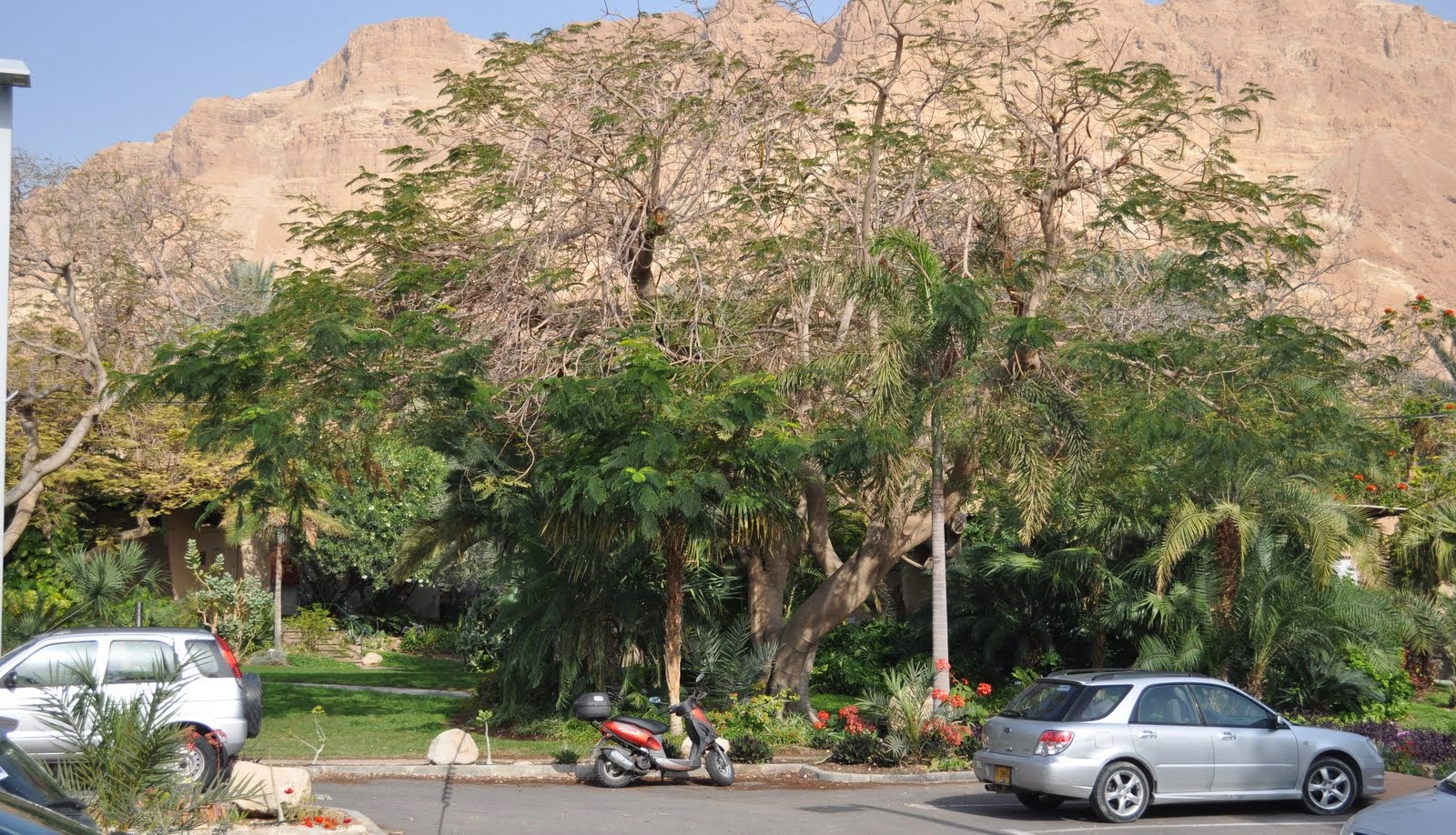 |
| Ein Gedi Kibbutz and hotel. |
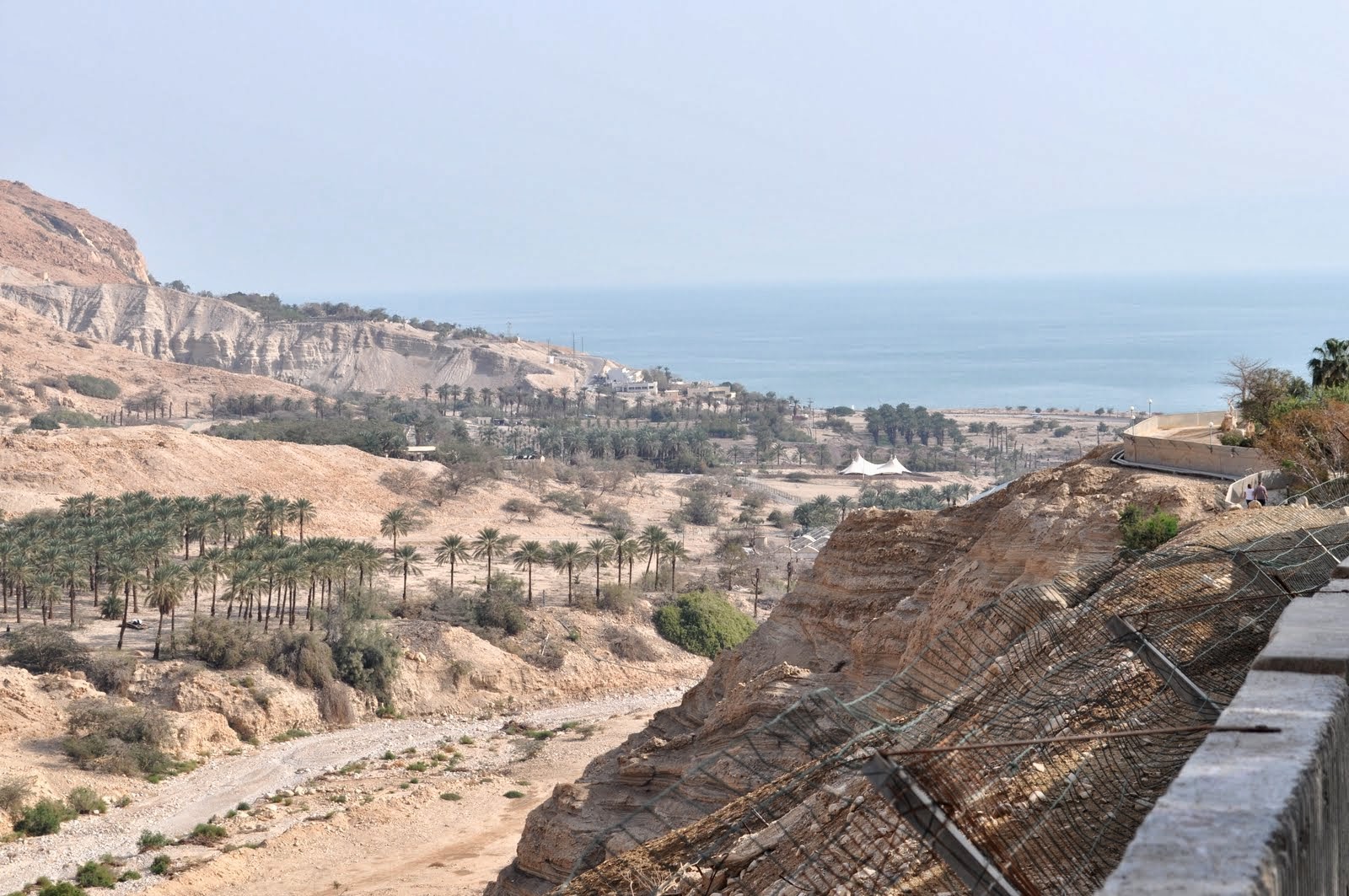 |
| View from Ein Gedi back to Dead Sea |
The parking attendant in Nazareth had suggested we drive the long way approaching Neve Zohar from the west, rather than driving through the West Bank. Driving an Israeli car which might not have been insured for this area and watching the Four Corners Program about the East Jerusalem I wasn't too keen about driving there. I actually brought an Australian flag to put in the car if we did, evidence of non Israeli occupants (I hoped). So we drove the way he suggested but on the way north Steve wanted to approach Jerusalem from the east, so it meant we had to take route 1, from north Dead Sea. It was so much shorter and meant we'd see other sites.
Jericho is one place I have wanted to see. We can teach about Jericho as a case study in Ancient History so driving so close we had to go in. The road in told a little of the story of this area. A large sign indicated that Israeli citizens were not allowed in to Palestinian controlled areas. We passed a car which had rolled off the road, and an old beaten up Mercedes overtook us at speed containing , as I told Michael "men who all were dressed like Yasser Arafat". The town looked poor. Market day meant many on the roads, but women walked right out in front of us as we drove. I felt fine to walk around but the car might have been a problem, so we left. Our observations regarding the places that Israeli jews lived and where Palestinians lived was again confirmed. Like the Bedouin town, it looked poor and rundown. We left in trepidation, but wished we could spend more time in the Palestinian areas.
Now the road to Jerusalem.....Part 3






























